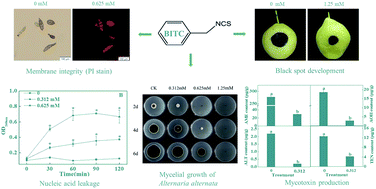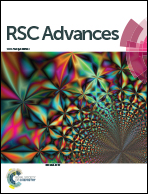Benzyl isothiocyanate fumigation inhibits growth, membrane integrity and mycotoxin production in Alternaria alternata†
Abstract
The antifungal activity of benzyl isothiocyanate (BITC) against pear pathotype-Alternaria alternata, the causal agent of pear black spot, and its possible mechanisms were studied. The results indicated that both the spore germination and mycelial growth of A. alternata were significantly inhibited by BITC in a dose-dependent manner. BITC concentrations at 1.25 mM completely suppressed mycelial growth of A. alternata and prevented ≥50% of black spot development in wounded pears inoculated with A. alternata. Microscopic analyses and propidium iodide (PI) staining showed that spore morphology in A. alternata treated with BITC at 0.625 mM was severely damaged. Relative electrical conductivity and lysis ability assays further showed that BITC treatment destroyed the integrity of the plasma membrane. Additionally, mycotoxin production was inhibited by 0.312 mM BITC, and the inhibitory rates of alternariol monomethyl ether (AME), alternariol (AOH), altenuene (ALT) and tentoxin (TEN) were 89.36%, 84.57%, 91.41% and 67.78%, respectively. The above results suggest that BITC exerts antifungal activity through membrane-targeted mechanisms.



 Please wait while we load your content...
Please wait while we load your content...